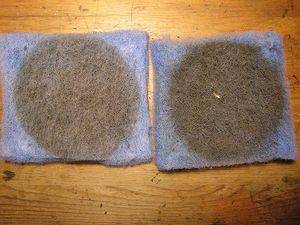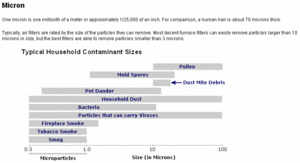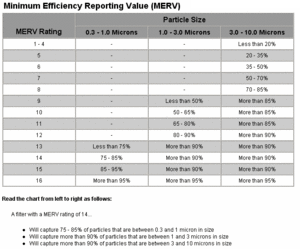Quazi
Member
Lately I've been seeing a lot of information out there about intakes without paying attention to filtering the intakes. No, not for smell; for the quality of air that your plants grow and live in. This is not something that you should overlook.
If you want proof: please continue reading. Before the pics though:
PLEASE FILTER YOUR AIR INTAKES
Growing indoors allows you to have an incredible control over the environment of your plants. This can be especially true for us micro growers. Especially those of us growing in a negative pressure environment (where your doors suck closed).
This part is important so pay attention:
When air enters a negative pressure environment, it will drop the heavier particles out of the stream of air as the air is moving from the intake to the exhaust. For most of us, the path from the intake to the exhaust is where our plants lie. Envision, if you will, a flock of birds, flying from your intake to your exhaust. Now, imagine all of those birds had a healthy dose of laxatives. Take that image and multiple it my hundreds of thousands, now millions. Wouldn't you like to do something to prevent that from happening to your plants? Especially delicate clones and seedlings?
I have read that you want air filters that are rated at least 1200 to catch all the nasties that could possibly hinder or even kill your plants. It's easy, cheap, and completely worth the peace of mind.
You can purchase a large sheet that is in the accordion-style with the metal meshing and cardboard frame. The metal meshing and frame come off easily enough, and you can cut pieces that will be suitable for your needs. Here's the one that I purchased:

Although there are other filtering mediums available for the intake, you want to be sure you're getting something that will be small enough to catch the mold spores and other small critters (and their eggs) which may cause harm to your lovelies. You should be sure that you have adequate ventilation to pull through these filters. I have a blower for my cabinet and it handles the filters without any problem. I cannot, however, speak for the ventilation setup of your situation so be smart and do a bit of investigation before you go slapping filters on your intakes. Please don't come back to this thread complaining that your cabinet temperature jumped since you added filters.
Even if you think your cabinet is in a clean environment, there are always factors that you cannot see which can (and probably will at some point) affect your growing experience.

Now then, with a happier face.
If that rant didn't convince you: it's time for the pictures.
I casually installed the air filters (thinking that it wouldn't really make an incredible impact) on my cabinet after it had gotten started and they were white and beautiful:
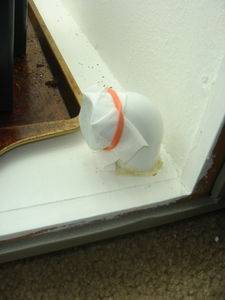
This was less than two weeks ago. Today, I went to take a closer photo of the intakes for another thread. As I got closer, I noticed there was a decent amount of buildup showing around the outside:

I removed the filter and it didn't look too bad...
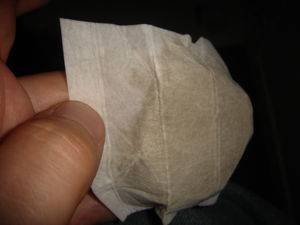
...until I turned it over:
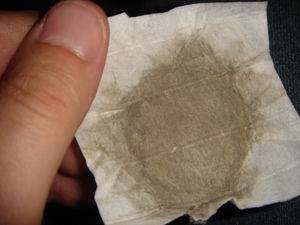
I'm no HVAC expert, so I can't tell you whether there's actually nasty stuff caught in there or if it's just dead skin cells. I can tell you, with confidence, that I'm glad that my plants weren't exposed to it so I could find out.
$15.00 for a sheet of air filter that will last you for months and some change for rubber bands...
...OR...
...take a closer look at what your plants will be exposed to in under two weeks:
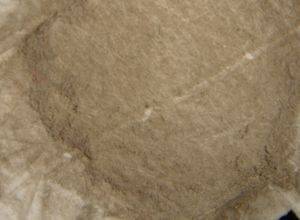
If you haven't already, I would strongly urge you to consider filtering your intakes in your micro grow.
Just a little friendly advice to help you along in your travels.
-Q
If you want proof: please continue reading. Before the pics though:
PLEASE FILTER YOUR AIR INTAKES
Growing indoors allows you to have an incredible control over the environment of your plants. This can be especially true for us micro growers. Especially those of us growing in a negative pressure environment (where your doors suck closed).
This part is important so pay attention:
When air enters a negative pressure environment, it will drop the heavier particles out of the stream of air as the air is moving from the intake to the exhaust. For most of us, the path from the intake to the exhaust is where our plants lie. Envision, if you will, a flock of birds, flying from your intake to your exhaust. Now, imagine all of those birds had a healthy dose of laxatives. Take that image and multiple it my hundreds of thousands, now millions. Wouldn't you like to do something to prevent that from happening to your plants? Especially delicate clones and seedlings?
I have read that you want air filters that are rated at least 1200 to catch all the nasties that could possibly hinder or even kill your plants. It's easy, cheap, and completely worth the peace of mind.
You can purchase a large sheet that is in the accordion-style with the metal meshing and cardboard frame. The metal meshing and frame come off easily enough, and you can cut pieces that will be suitable for your needs. Here's the one that I purchased:
Although there are other filtering mediums available for the intake, you want to be sure you're getting something that will be small enough to catch the mold spores and other small critters (and their eggs) which may cause harm to your lovelies. You should be sure that you have adequate ventilation to pull through these filters. I have a blower for my cabinet and it handles the filters without any problem. I cannot, however, speak for the ventilation setup of your situation so be smart and do a bit of investigation before you go slapping filters on your intakes. Please don't come back to this thread complaining that your cabinet temperature jumped since you added filters.
Even if you think your cabinet is in a clean environment, there are always factors that you cannot see which can (and probably will at some point) affect your growing experience.

Now then, with a happier face.
If that rant didn't convince you: it's time for the pictures.
I casually installed the air filters (thinking that it wouldn't really make an incredible impact) on my cabinet after it had gotten started and they were white and beautiful:
This was less than two weeks ago. Today, I went to take a closer photo of the intakes for another thread. As I got closer, I noticed there was a decent amount of buildup showing around the outside:
I removed the filter and it didn't look too bad...
...until I turned it over:
I'm no HVAC expert, so I can't tell you whether there's actually nasty stuff caught in there or if it's just dead skin cells. I can tell you, with confidence, that I'm glad that my plants weren't exposed to it so I could find out.
$15.00 for a sheet of air filter that will last you for months and some change for rubber bands...
...OR...
...take a closer look at what your plants will be exposed to in under two weeks:
If you haven't already, I would strongly urge you to consider filtering your intakes in your micro grow.
Just a little friendly advice to help you along in your travels.
-Q

Last edited:

